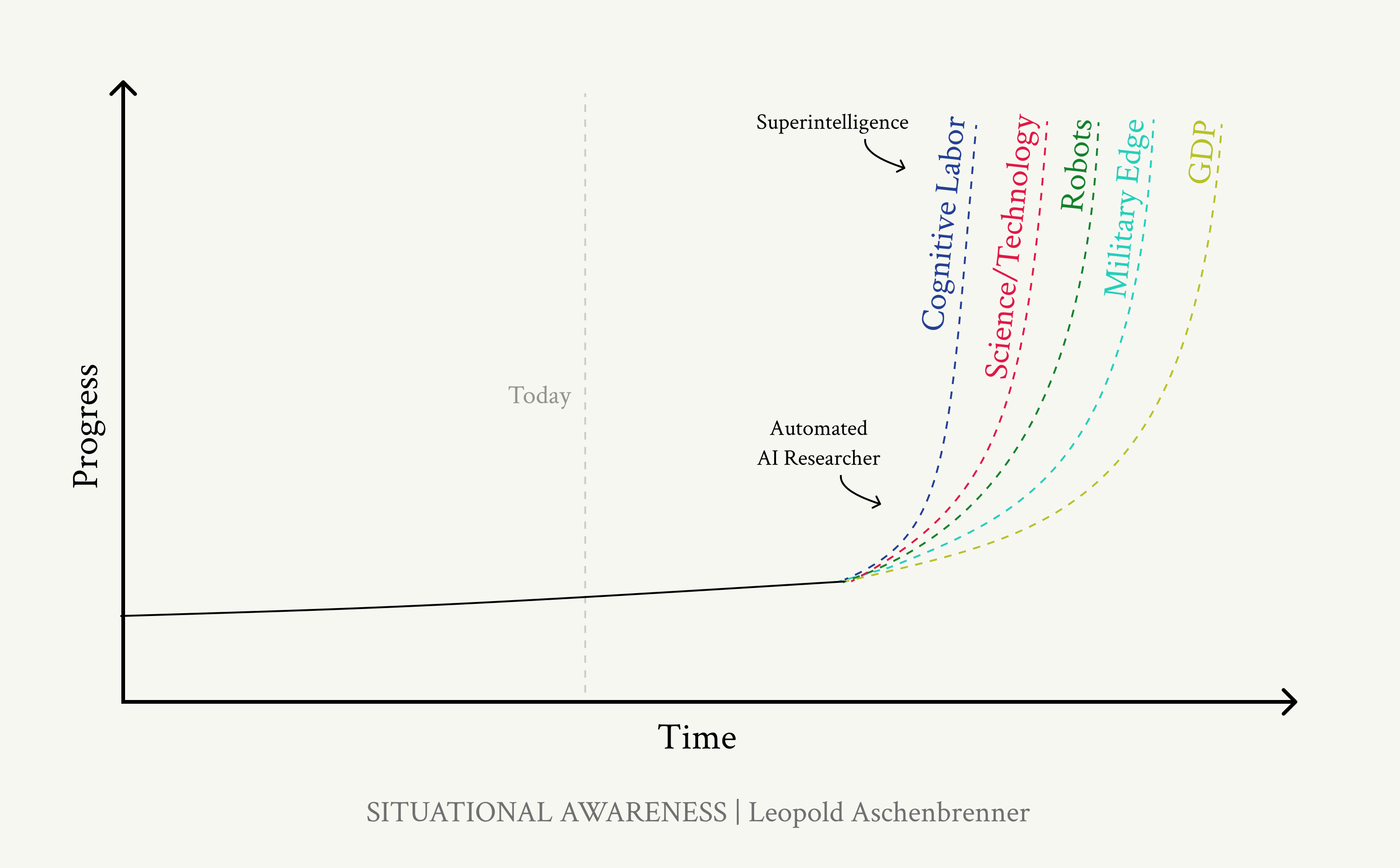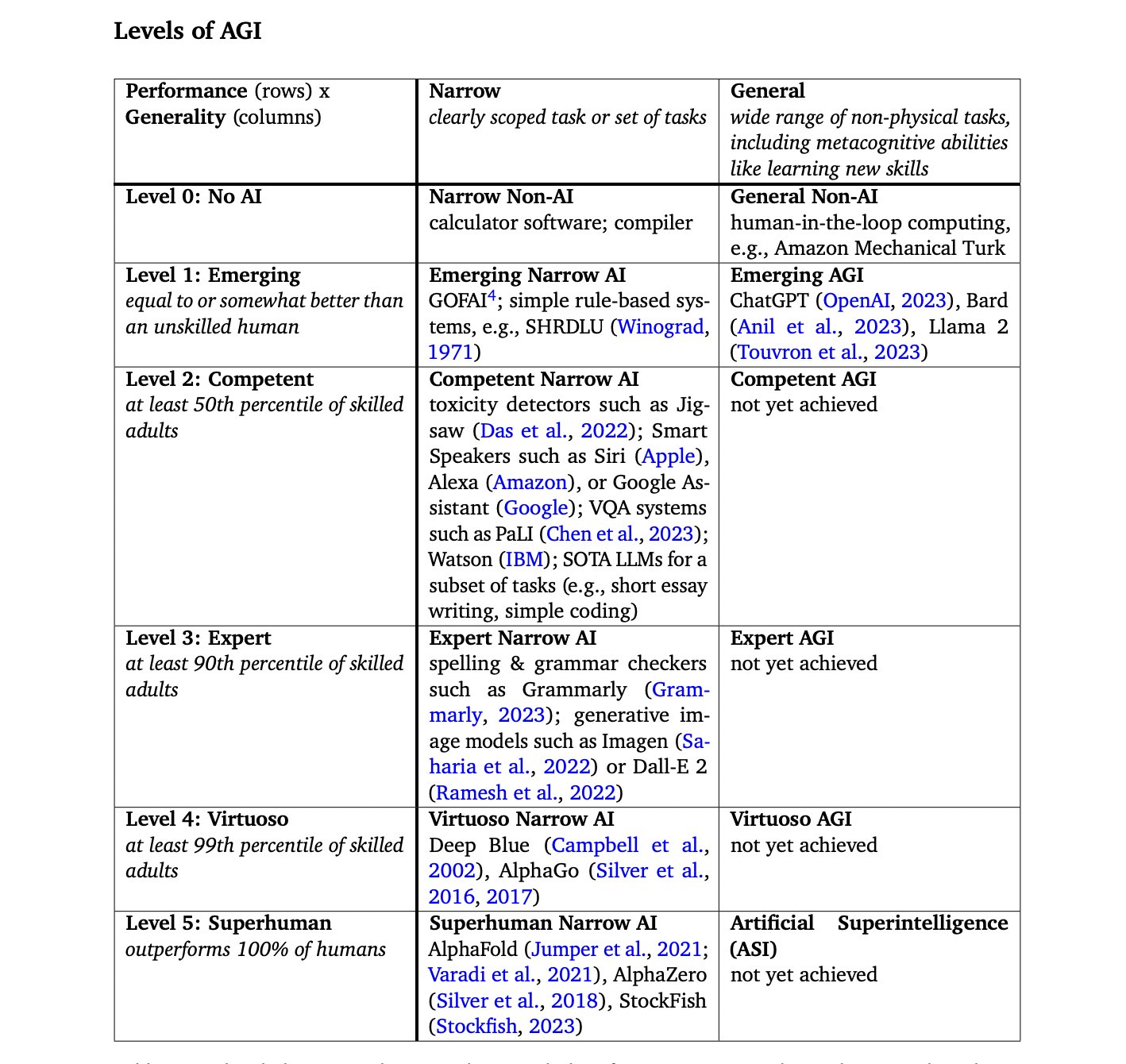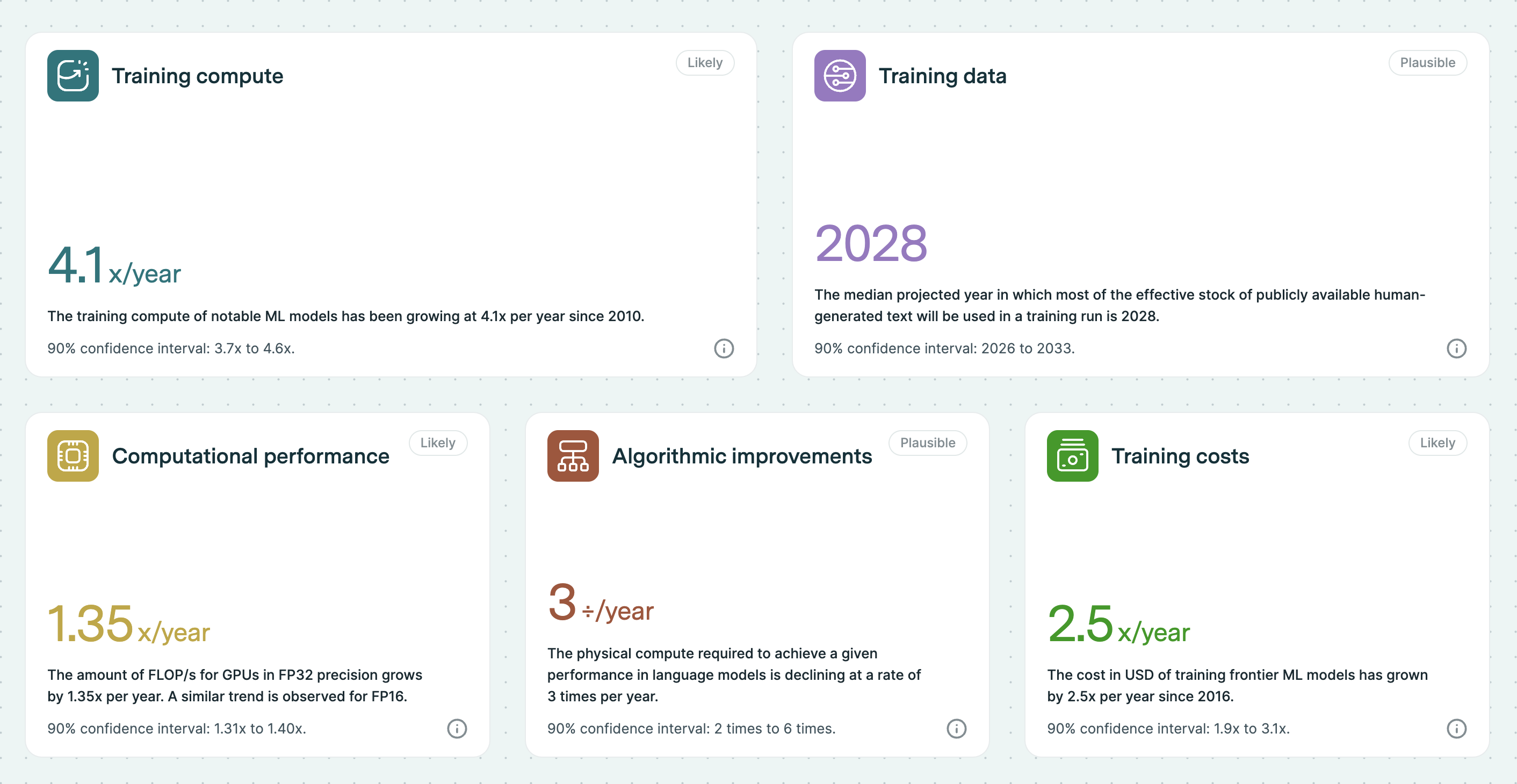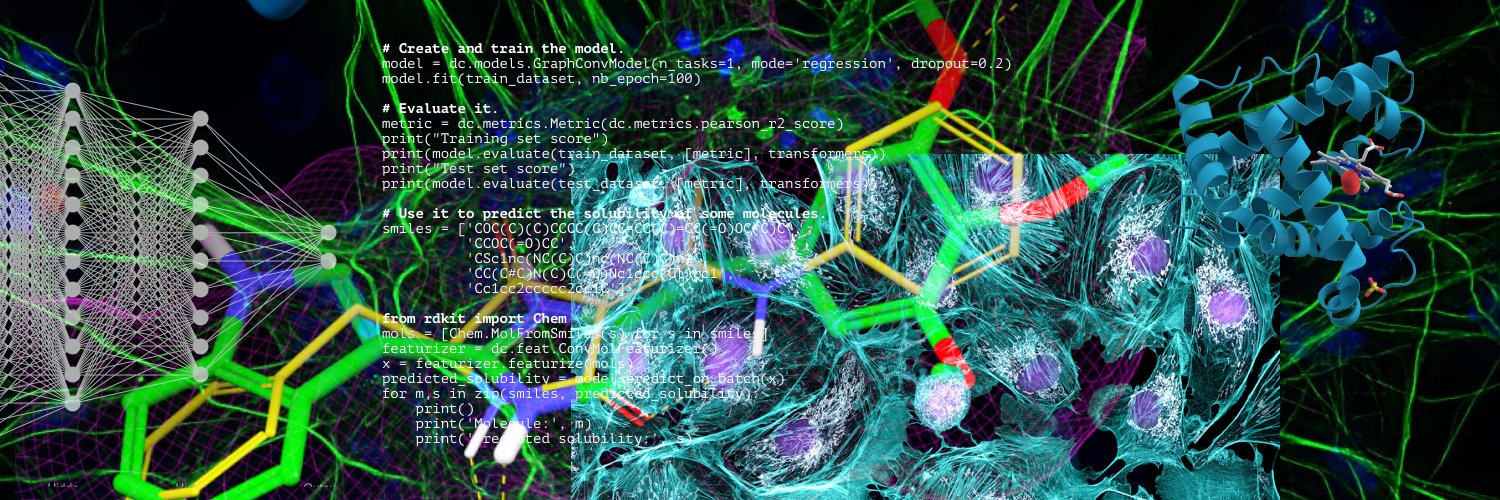The Intelligence Age - Navigating the Path to Transformative AI

We stand at the dawn of the Intelligence Age, an era where Artificial Intelligence (AI) is rapidly advancing from narrow intelligence to more general and ultimately likely superintelligent systems across many domains. AI is beginning to redefine and augment human capabilities, transforming every aspect of our world. Advances in machine learning algorithms, computational scaling, and data have brought accelerated AI progress. As we progress toward artificial general intelligence (AGI) and eventually superintelligence (ASI), it is crucial to understand the implications and potential paths for how this technological revolution unfolds.
Understanding AI, AGI, and ASI
Artificial Intelligence (AI)
AI refers to the development of machines capable of performing tasks that typically require human intelligence, such as natural language understanding, pattern recognition, decision-making, and problem-solving.
Artificial General Intelligence (AGI)
AGI represents AI systems that possess the ability to understand, learn, and apply knowledge across a broad range of tasks at a level comparable to humans. This marks a pivotal milestone where machines can perform any intellectual task that a human can.
Artificial Superintelligence (ASI)
ASI surpasses human intelligence across all domains, capable of recursive self-improvement, and potentially leading to an intelligence explosion.
Levels of AGI: Operationalizing Progress
Achieving AGI does not require human-like thinking, consciousness, or brain-like mechanisms. The focus should be on what an AGI system can do:
- AGI defined by capability scope (generality) and quality (performance), not human-like traits.
- Emphasize cognitive breadth and depth over physical tasks.
- Focus on potential rather than deployment to avoid non-technical barriers.
- AGI benchmarks should mirror valued human tasks, not just AI metrics.
- Progress is marked by gradations in generality and performance, aiding risk assessment.
- Proposes a 5-tier performance, 2-tier generality taxonomy for AGI tracking.

—
The Technical Foundations of AI
Core Concepts of AI and Machine Learning
Understanding foundational AI techniques is crucial for grasping the field’s potential:
- Supervised Learning: Training models on labeled data to make predictions.
- Unsupervised Learning: Discovering patterns in unlabeled data.
- Reinforcement Learning: Learning optimal actions through trial and error.
- Deep Learning: Utilizing neural networks with multiple layers to model complex patterns.
- Transfer Learning: Applying knowledge from one domain to improve learning in another.
Transformers and Their Impact
Transformers have revolutionized natural language processing (NLP) and beyond by enabling models to understand context and relationships in data more effectively. Huggingface has fantastic docs explaining transformers and how to use them.
Key Features:
- Attention Mechanisms: Allowing models to focus on relevant parts of the input.
- Parallelization: Enabling efficient training on large datasets.
The Accelerating Pace of AI Development
Scaling Laws and Computational Growth
- Exponential Increase in Compute: Advances in hardware, such as GPUs and TPUs, and architectural innovations have led to exponential growth in computational resources available for training AI models.
- Predictable Performance Improvements: Scaling laws indicate that increasing model size and training data leads to predictable improvements in AI capabilities, enabling models to exhibit emergent behaviors and competencies previously unattainable.
Algorithmic Innovations
- Transformers and Attention Mechanisms: The introduction of transformer architectures has revolutionized natural language processing and other domains by allowing models to understand context and relationships more effectively.
- Efficiency Improvements: Optimizations in training techniques reduce the resources required for performance gains, making it feasible to train larger models without proportional increases in computational cost.
 EpochAI offers great data and trends on AI progress
EpochAI offers great data and trends on AI progress
Resource Investment and Autonomous Agents
- Massive Investment: Significant capital is being invested in AI research and infrastructure globally, reflecting recognition of AI’s transformative potential.
- Transition to Autonomous Agents: Moving from passive models to autonomous agents capable of interacting with and learning from their environment is expected to significantly enhance AI capabilities.
From Current AI to AGI: A Plausible Trajectory
Biological Insights and Compute Trends
- Scaling Intelligence with Compute: The human brain can be considered a scaled-up primate brain, suggesting that intelligence correlates with computational capacity. AI systems are not constrained by biological limitations and can surpass human cognitive capabilities through increased compute.
- Timeline to AGI: Given current trends in computational growth and algorithmic efficiency, AGI may be achievable within the next decade.
Feedback Loops Accelerating Progress
- AI-Assisted AI Development: AI systems can contribute to their own development by assisting in research, code generation, and optimization, creating positive feedback loops that accelerate advancement.
- Economic Incentives: Revenue from AI applications fuels further investment in AI research, leading to larger training runs and more powerful models.
The Intelligence Explosion and Superintelligence
Recursive Self-Improvement
- Intelligence Explosion: Once AI systems reach a certain level of capability, they may rapidly improve themselves without direct human intervention, leading to an exponential increase in intelligence.
- Surpassing Human Cognition: ASI systems could operate at speeds and with cognitive abilities far beyond human limitations, potentially solving complex problems and making discoveries unattainable by humans.
Economic Transformation
- Accelerated Growth: An AI-driven economy could experience unprecedented growth rates, limited primarily by physical constraints such as energy production and manufacturing capabilities.
- Automation of Innovation: AI systems could automate research and development across all scientific and technological domains, leading to rapid technological advancement.
Transformative Impacts Across Key Sectors
- Science and Technology
- Accelerated Discovery: AI can dramatically speed up scientific research, leading to breakthroughs in fields like physics, chemistry, and materials science.
- Engineering Advancements: AI-driven design optimization can revolutionize engineering processes, resulting in more efficient and sustainable technologies.

- Healthcare and Medicine
- Personalized Medicine: AI enables the analysis of vast genomic and clinical data, allowing for treatments tailored to individual patients.
- Drug Discovery: Accelerated identification of therapeutic compounds through AI modeling of molecular interactions.
- Understanding Complex Biological Systems: AI models can simulate biological processes, aiding in the understanding of diseases and development of novel treatments.
- Diagnostics and Personalized Medicine: Enhancing diagnostics, personalizing treatment plans, accelerating drug discovery, and understanding complex biological systems.
- Manufacturing and Automation
- Intelligent Automation: Deployment of AI-powered robots capable of complex tasks with precision and efficiency.
- Rapid Production Scaling: Exponential growth in production capabilities due to AI-driven automation of manufacturing processes.
- Autonomous Transportation: Developing autonomous vehicles and optimizing logistics.
- Energy: Managing smart grids and improving sustainability.
- Economic Development
- Productivity Gains: AI can significantly enhance productivity across industries, driving economic growth.
- Resource Optimization: AI algorithms can optimize the allocation and use of resources, improving efficiency and sustainability.
- Environmental Sustainability
- Climate Change Mitigation: AI can develop innovative solutions for reducing greenhouse gas emissions and managing environmental impacts.
- Resource Conservation: Optimization of energy use, waste reduction, and sustainable resource management through AI systems.
Arguments for Explosive Economic Growth Driven by AI
Automation of Labor
- Scalable Digital Workforce: AI can substitute human labor in many tasks, effectively creating a scalable workforce that can be expanded rapidly.
- Increasing Returns to Scale: Economic models predict that when labor can be scaled, and all key inputs are accumulable, growth accelerates due to increasing returns.
AI-Assisted Research and Development
- Recursive Improvement: AI systems contribute to technological advancements, which in turn enhance AI capabilities—a positive feedback loop.
- Accelerated Innovation: AI can expedite R&D processes, leading to faster technological progress and economic growth.
Rapid Expansion of AI Capabilities
- Cost-Effective Scaling: If AI systems are cost-efficient, the stock of AI workers can grow rapidly, boosting economic output.
- Investment Incentives: High potential returns incentivize substantial investments in AI, further accelerating development.
Overcoming Traditional Bottlenecks
- Non-Physical Constraints: AI can mitigate limitations posed by scarce human labor and other non-scalable factors, enabling sustained growth.
- Energy and Resource Efficiency: Advances in AI can lead to more efficient use of physical resources, delaying the impact of physical constraints on growth.
Technological Challenges and Alignment
AI Safety and Alignment: Ensuring It All Goes Well
When it comes to AI, safety and alignment are critical. Without taking the proper precautions, AI can pose a serious threat to humans and the world at large. Ensuring that AI systems are reliable, trustworthy, and act in ways that are beneficial to humanity is paramount.
Three key areas to focus on:
- Control: Developing mechanisms to monitor and manage AI systems to prevent unintended consequences. This includes having the ability to shut them down if necessary and prevent them from causing harm.
- Values Alignment: Ensuring AI systems understand and adhere to human values and ethics. They should be designed to promote the welfare of humans, not harm them.
- Goal Compatibility: Aligning AI objectives with human goals to avoid harmful outcomes. For example, an AI system designed to cure cancer would have a goal compatible with human values.
Approaches to AI Alignment
- Ethical Frameworks: Integrating ethical considerations into AI design and deployment.
- Technical Solutions: Developing algorithms and techniques for value alignment and control.
- Human-AI Collaboration: Designing systems that can effectively interact and cooperate with humans.
- Research and Development: Focusing on AI interpretability, scalable oversight, and robustness.
The Challenge of Aligning Superhuman AI Systems
- Superalignment Problem: Ensuring that AI systems much smarter than humans act in ways that align with human values is critical.
- Limitations of Current Methods: Techniques like Reinforcement Learning from Human Feedback (RLHF) may not scale effectively to superintelligent AI due to the supervision gap.
Weak-to-Strong Generalization
- Generalization from Limited Supervision: Developing methods for AI to generalize desired behaviors from simpler tasks to complex, unsupervised ones.
- Research Focus: Investigating how models can learn from weak supervision and ensuring they generalize correctly is crucial.
Interpretability and Transparency
- Understanding AI Decision-Making: Gaining insights into the internal workings of AI models is essential for trust and safety.
- Mechanistic Interpretability: Reverse-engineering neural networks to understand fundamental processing mechanisms.
- Detecting Misalignment: Interpretability tools help identify undesirable behaviors, such as deception or manipulation.
Scalable Oversight
- AI-Assisted Evaluation: Leveraging AI to assist humans in overseeing other AI systems, especially in complex tasks beyond human comprehension.
- Strategies for Implementation: Techniques like debate, recursive reward modeling, and AI-assisted critique enhance oversight capabilities.
Other Alignment Research Directions
- Honesty and Truthfulness: Ensuring AI systems consistently provide accurate information and do not engage in deceptive behaviors.
- Adversarial Robustness: Developing AI systems resilient to manipulation and adversarial inputs to prevent misalignment.
Challenges and Risks
Security Risks
- Misuse of AI: Advanced AI could be exploited for malicious purposes, such as cyberattacks, disinformation campaigns, or autonomous weapon systems.
- Global Competition: An international race for AI dominance may prioritize speed over safety, increasing risks.
Regulatory Challenges
- Balancing Innovation and Safety: Crafting policies that encourage technological advancement while mitigating risks is complex.
- Enforceability Issues: Global coordination is required to implement effective regulations, which may be challenging due to differing national interests.
Economic and Social Disruption
- Labor Market Impact: Automation of routine and even complex tasks could lead to significant unemployment without adequate transition strategies.
- Inequality Risks: Benefits of AI may not be evenly distributed, potentially widening socioeconomic disparities.
Cultural and Societal Shifts
- Adaptation Challenges: Rapid changes may outpace society’s ability to adapt, leading to cultural and ethical dilemmas.
- Dependency Concerns: Overreliance on AI could diminish human skills and autonomy.
Existential Risks
- Loss of Control: Superintelligent AI systems might make decisions that are harmful or beyond human understanding.
- Alignment Failures: Misaligned goals between AI and humanity could lead to catastrophic outcomes.
- Unintended Consequences: AI actions could have far-reaching effects due to the interconnectedness of global systems.
- Irreversibility: Some consequences of AI actions may be irreversible, necessitating precautionary measures.
Navigating the Path Forward
Collaborative Effort and Inclusivity
- Multidisciplinary Approach: Solving alignment and safety challenges requires collaboration across AI research, ethics, policy, and social sciences.
- International Cooperation: Global collaboration is essential to address risks and ensure equitable benefits.
Ethical Leadership and Policy Development
- Transparent Practices: Openness about AI capabilities and limitations fosters trust and facilitates oversight.
- Adaptive Governance: Regulatory frameworks must be flexible to keep pace with rapid technological advancements.
Investment in Alignment Research
- Dedicated Resources: Allocating significant resources to AI safety research is imperative to develop robust alignment solutions.
- Public Engagement: Educating and involving the public in discussions about AI’s future encourages diverse perspectives and shared responsibility.
Conclusion
The potential of AGI and ASI to drive explosive economic growth and transform society is immense. While the opportunities are extraordinary, they are accompanied by significant challenges and risks, particularly concerning alignment and safety. By proactively addressing these issues through collaborative efforts, ethical leadership, and dedicated research, we can navigate the path toward a future where AI acts as a force for unprecedented good.
As we stand at this pivotal juncture, the decisions we make will shape the trajectory of human civilization. Embracing the Intelligence Age with wisdom and foresight is essential to ensure that the advancements in AI lead to a prosperous and equitable future for all.
—
References and Further Reading
Books:
- Artificial Intelligence: A Modern Approach by Stuart Russell and Peter Norvig
- Deep Learning: Foundations and Concepts
- Deep Learning by Ian Goodfellow, Yoshua Bengio, and Aaron Courville
- Neural Networks and Deep Learning by Michael Nielsen
Papers
- DeepMind. “Levels of AGI: Operationalizing Progress on the Path to AGI.”
Online Courses:
- Coursera: Offers comprehensive AI and ML courses.
- fast.ai: Provides practical deep learning courses.
Videos and Lectures:
- “But what is a neural network?” by 3Blue1Brown
- “Let’s Build GPT: From Scratch, In Code, Spelled Out” by Andrej Karpathy
- Reinforcement Learning: Understanding how agents learn to make decisions.
- Reinforcement Learning Lecture Series by DeepMind x UCL
Essays
- Leopold Aschenbrenner “Situational Awareness: The Decade Ahead.”
- Dario Amodei “How AI Could Transform the World for the Better.”
- Sam Altman “The Intelligence Age.”
- Carl Shulman Insights on intelligence explosion and AI alignment.
- Richard Ngo “A Short Introduction to Machine Learning.”
- Andrej Karpathy “Educational resources on neural networks and deep learning.”
- Software 2.0 by Andrej Karpathy
- The AI Revolution: The Road to Superintelligence on Wait But Why
- Transformer Tutorial by Hugging Face
Websites
- Epoch AI. “Explosive Growth from AI: A Review of the Arguments.”
- Alignment Newsletter Podcast
- OpenAI’s Superalignment Research Directions
- Leopold Aschenbrenner - 2027 AGI, China/US Super-Intelligence Race, & The Return of History